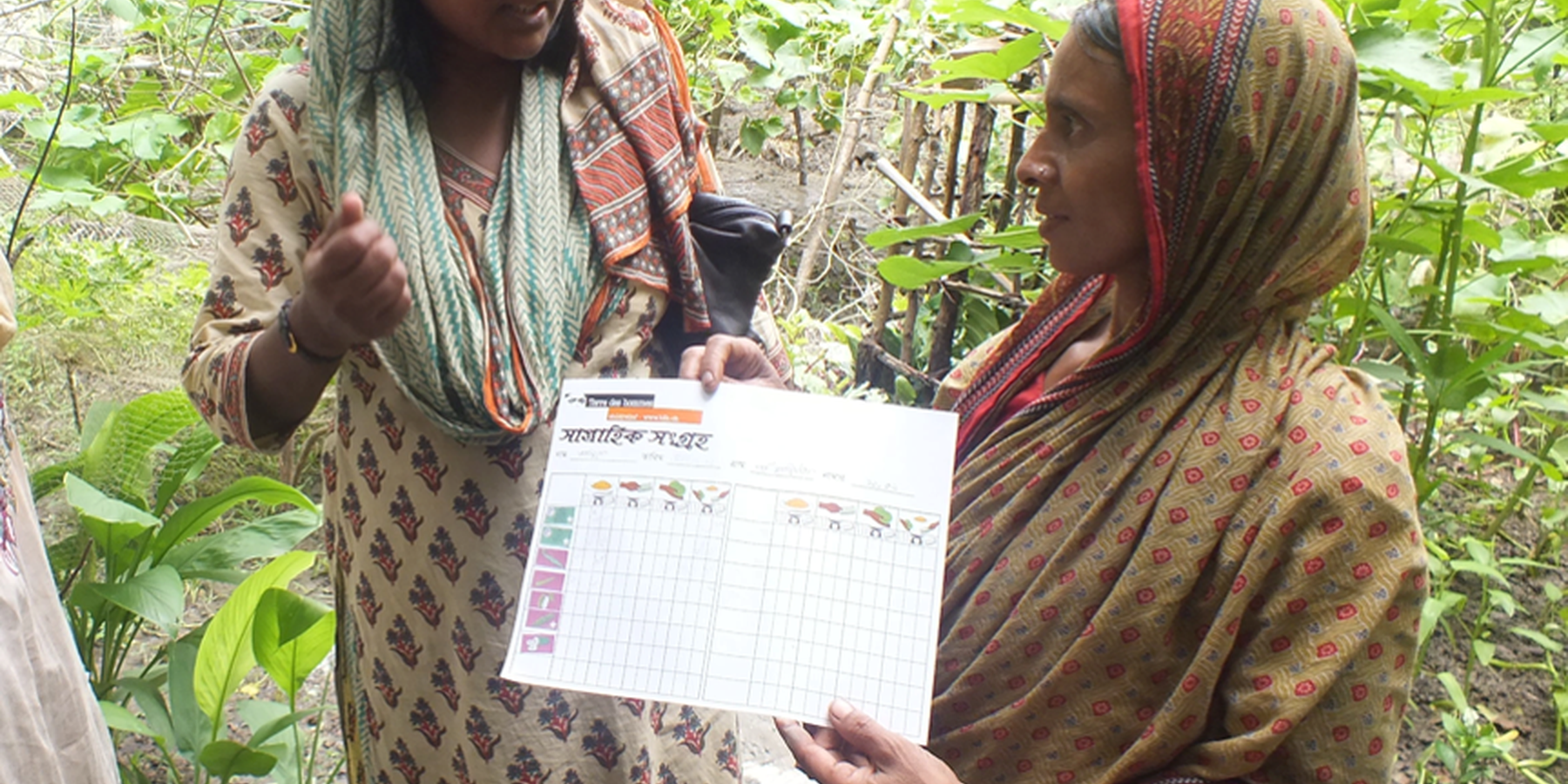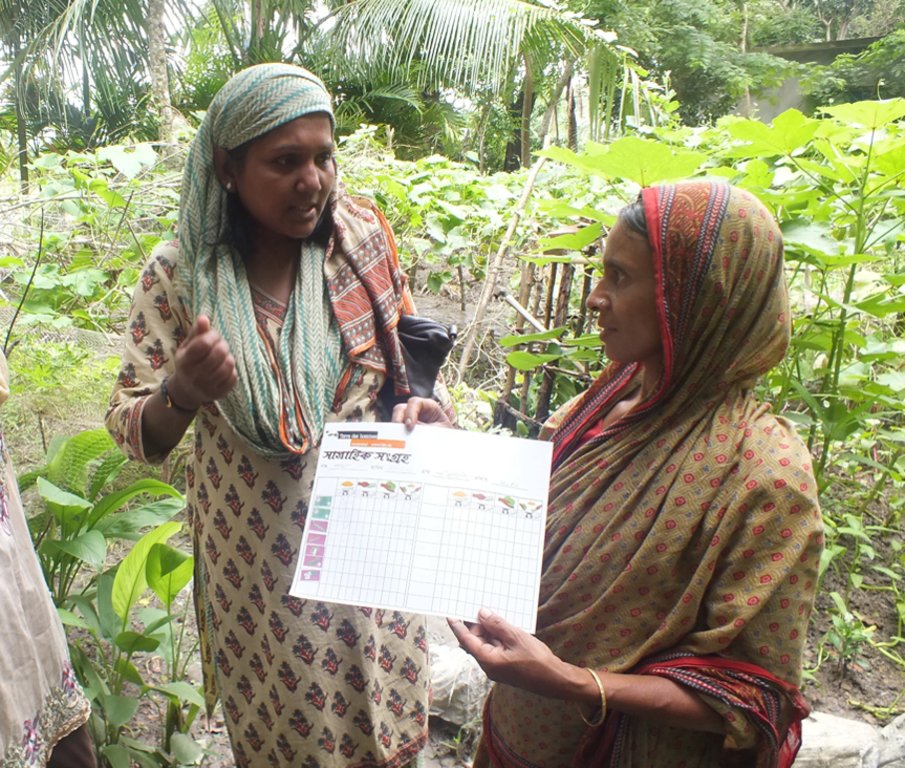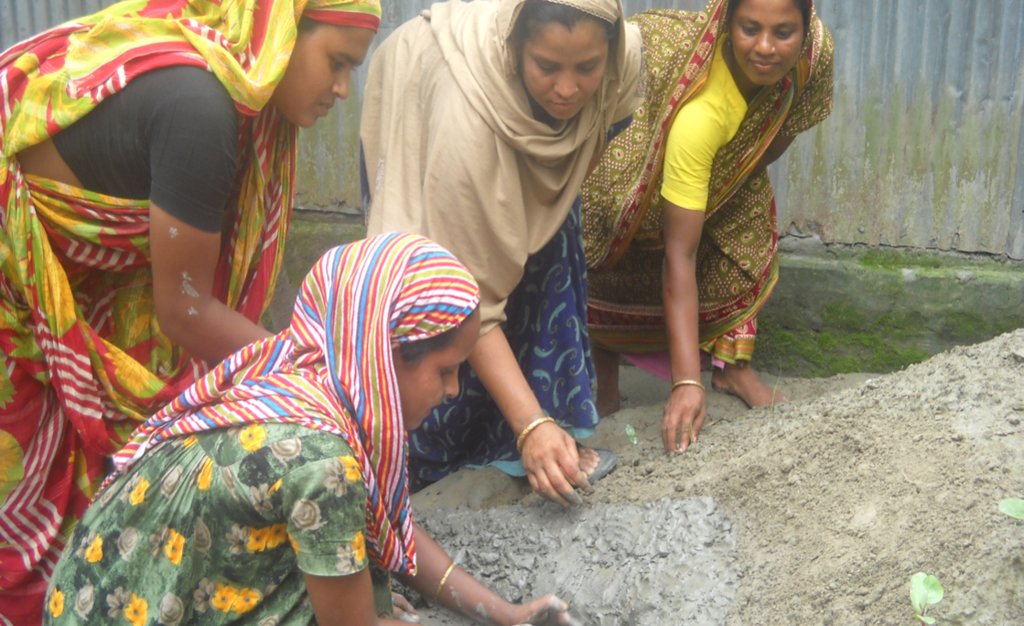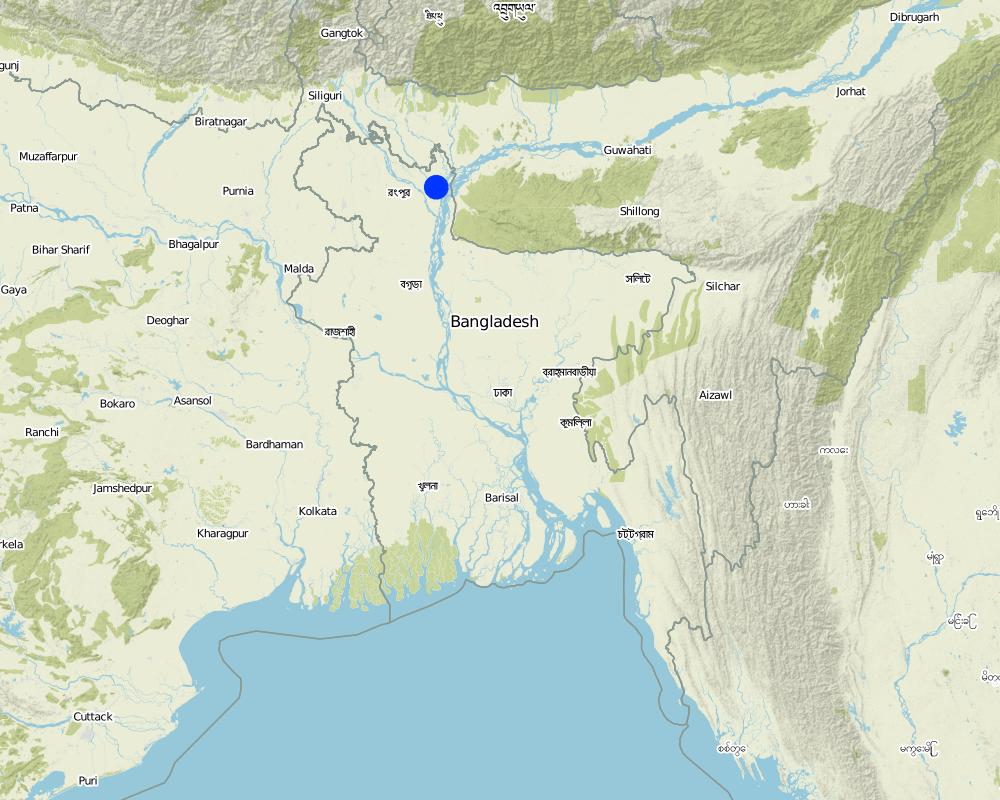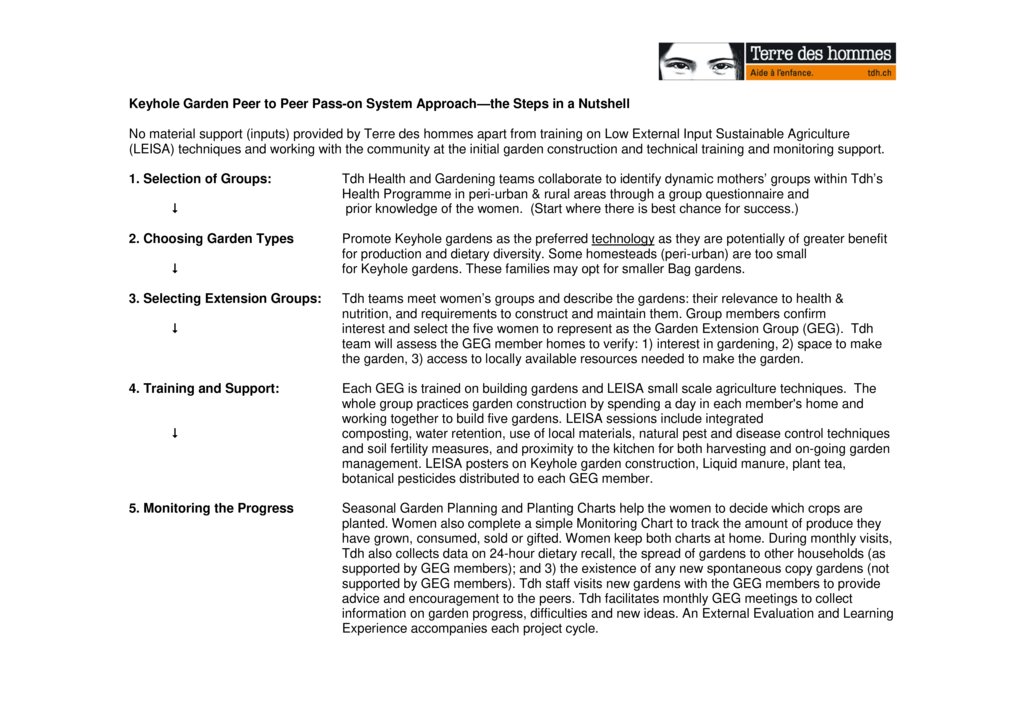Peer to Peer Pass-on Approach with Women [Bangladesh]
- Creación:
- Actualización:
- Compilador: John Brogan
- Editor: Shahid Kamal
- Revisores: Alexandra Gavilano, Boris Orlowsky
approaches_784 - Bangladesh
Visualizar secciones
Expandir todo Colapsar todos1. Información general
1.2 Detalles de contacto de las personas de referencia e instituciones involucradas en la evaluación y la documentación del Enfoque
Persona(s) de referencia clave/s
Especialista MST:
Brogan John
john.brogan@tdh.ch
Terre des hommes
15 Avenue Montchoisi 1006 Lausanne
Suiza
WASH/DRR Advisor:
Especialista MST:
Taylor Sheila
Sheila.Taylor@sendacow.org
Send a Cow UK
Nombre del proyecto que facilitó la documentación/ evaluación del Enfoque (si fuera relevante)
Book project: where people and their land are safer - A Compendium of Good Practices in Disaster Risk Reduction (DRR) (where people and their land are safer)Nombre de la(s) institución(es) que facilitaron la documentación/ evaluación del Enfoque si fuera relevante)
Terre des Hommes (Terre des Hommes) - Suiza1.3 Condiciones referidas al uso de datos documentados mediante WOCAT
¿Cuándo se compilaron los datos (en el campo)?
14/08/2013
El compilador y la/s persona(s) de referencia claves aceptan las condiciones acerca del uso de los datos documentados mediante WOCAT :
Sí
1.4 Referencia/s al/los Cuestionario(s) de Tecnologías MST
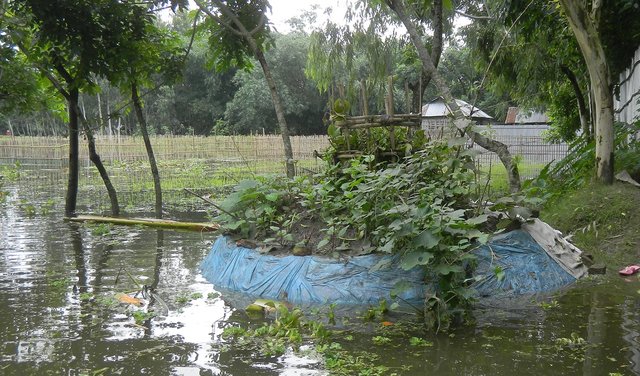
Keyhole Garden [Bangladesh]
The Keyhole Garden model of homestead vegetable cultivation enhances the resilience of families living in areas with climate-related hazards, such as flooding and drought. Keyhole gardens have been shown to increase vegetable production in all seasons, thereby improving household food autonomy and dietary diversity.
- Compilador: John Brogan
2. Descripción del Enfoque MST
2.1 Breve descripción del Enfoque
Terre des hommes and Greendots introduced the Peer to Peer pass-on system to enable women's groups in Bangladesh to spread the Keyhole Garden technique within their communities with the aim of enabling year-round homestead vegetable production despite the risk of flooding and tidal surge.
2.2 Descripción detallada del Enfoque MST
Descripción detallada del Enfoque MST:
Keyhole Gardens, a type of small, productive homestead vegetable garden based on Low External Input Sustainable Agriculture (LEISA) techniques, have been used in various African countries for over 15 years and shown to increase the availability of food and dietary diversity (FAO). They were developed by gardeners and small-scale farmers (with the support of Send a Cow UK) to suit different situations, such as the cold, dry winters of Lesotho, the small backyards of Rwanda, and the humid heat of central Uganda. To improve year-round homestead nutritional self-sufficiency for vulnerable families in South Asia (where rates of acute malnutrition in young children regularly cross emergency thresholds), Keyhole gardens were adapted by Terre des hommes (Tdh) and Greendots to the conditions of river basin and coastal areas of Bangladesh (and eventually to India's Sundarbuns) . As a component to Tdh's maternal neonatal and child health (MNCH) programme, the technology is intended to support year-round homestead gardening despite weather extremes (flooding, tidal surge, cyclones).
To promote spontaneous replication of the Keyhole gardening in the local communities, the programme initiated a Peer to Peer Pass-on system within 40 mothers' groups (having a total membership of nearly 800 women). Each mothers' group selected five representatives (200 women) to form a Garden Extension Group (GEG) and participate in the first round of training with the understanding that they would share knowledge with other women in the MNCH programme and the surrounding community. The project team trained each GEG on building gardens and LEISA small scale agriculture techniques (including integrated composting, water retention, use of local materials, natural pest and disease control techniques and soil fertility measures, proximity to the kitchen for optimal management and harvesting). GEG group members practiced garden construction by working together to build gardens at the homes of all five members. All 200 initial gardens were monitored by Tdh extension workers on a weekly basis. Tdh verified output, use and the capacity of gardens to withstand monsoon conditions, and the extent of the of the Peer to Peer Pass-on experience.
See the Chart in Section 3.3 for more information.
2.3 Fotos del Enfoque
2.4 Videos del Enfoque
Comentarios, descripción breve:
https://www.youtube.com/watch?v=WmDgGa0XIO8
BBC Media Action Bangladesh produced a segment on its "Amrai Pari" programme for the Bangladeshi public (in Bangla language) describing women's use and promotion of the Keyhole Garden technique in coastal communities on the Bay of Bengal.
Fecha:
09/11/2014
Lugar:
Barguna District, Barisal Division, Bangladesh
Nombre del videógrafo:
BBC Media Action
2.5 País/ región/ lugares donde el Enfoque fue aplicado
País:
Bangladesh
Región/ Estado/ Provincia:
Kurigram District / Rajshahi Division and Barguna District / Barisal Division
Especifique más el lugar :
Kurigram municipality (Kurigram District), Patharghata Union (Barguna District)
Map
×2.6 Fechas de inicio y conclusión del Enfoque
Indique año del inicio:
2012
2.7 Tipo de Enfoque
- proyecto/ basado en un programa
2.8 Propósitos/ objetivos principales del Enfoque
The main aims of the approach are to involve women by building their capacity and peer network to replicate the Keyhole gardening approach within their communities.
The main objective of the approach is that that families, led by women 1) garden year-round with LEISA techniques, 2) increase the quantity and diversity of their homestead vegetable production and 3) verify that the DRR garden design reduces the consequences of flooding and tidal surge.
2.9 Condiciones que facilitan o impiden la implementación de la/s Tecnología/s aplicadas bajo el Enfoque
normas y valores sociales/ culturales/ religiosos
- facilitan
Acceptance of women's groups, existing mothers' groups within Health programme
conocimiento de MST, acceso a apoyo técnico
- facilitan
The Approach calls for capacity building on LEISA techniques (knowledge on SLM) via the Peer to Peer Pass-on system to spread the DRR-designed gardens.
3. Participación y roles de las partes interesadas involucradas
3.1 Partes interesadas involucradas en el Enfoque y sus roles
- usuarios locales de tierras/ comunidades locales
Homestead land users (women)
Building the gardens: learning and eventually training their peers
- organizaciones comunitarias
Mothers' groups
Garden extension groups to share the Keyhole Garden techniques within the scope of their maternal neonatal & child health & activities
- especialistas MST/consejeros agrícolas
Greendots (www.greendots.ch)
Technical support with design of the approach: Daniel Varadi and Sheila Taylor.
- organización internacional
Terre des hommes (international NGO)
Project implementing Agency, direct connection with women's groups within its MNCH Programme via Dr. Sultana Al-Amin (Gardening Specialist).
Si varias partes interesadas estuvieron involucradas, indique la agencia principal:
Terre des hommes
3.2 Involucramiento de los usuarios locales de tierras/ comunidades locales en las distintas fases del Enfoque
| Involucramiento de los usuarios locales de tierras/ comunidades locales | Especifique quién se involucró y describa las actividades | |
|---|---|---|
| iniciación/ motivación | pasivo | Terre des hommes and Greendots working through existing women's MNCH nutrition groups, requested groups to nominate five women to receive the training. |
| planificación | pasivo | As with all village-level activities, Terre des hommes works with a community volunteer in each village to plan the training and group interventions. |
| implementación | auto-movilización | Once the women were trained, they were free to honor their commitments to train other women. |
| monitoreo y evaluación | interactivo | Self planning and monitoring tools were introduced to the women--who decided whether to use them. Tdh provided monthly support visits to help interested women to update the planning and monitoring documents as needed, and to collect data. |
3.3 Flujograma (si estuviera disponible)
3.4 La toma de decisiones en la selección de Tecnología(s) MST
Especifique quién decidió la selección de las Tecnología/ Tecnologías a implementarse:
- principalmente usuarios de tierras con el apoyo de especialistas MST
Explique:
The Keyhole garden technique was introduced by Tdh, and went through informal adaptation and development with farmers and women's groups so that the final design was chosen by the communities and reflected the construction preferences and innovations of the users.
Especifique las bases que sustentaron la toma de decisiones:
- la experiencia personal y opiniones (no documentadas)
4. Apoyo técnico, fortalecimiento institucional y gestión del conocimiento
4.1 Construcción de capacidades / capacitación
¿Se proporcionó la capacitación a usuarios de tierras/ otras partes interesadas?
Sí
Especifique quién fue capacitado:
- usuarios de tierras
- personal de campo/ consejeros
Forma de capacitación:
- en el contexto de trabajo
- de agricultor a agricultor
4.2 Servicio de asesoría
¿Los usuarios de tierras tienen acceso a un servicio de asesoría?
Sí
Especifique si servicio proporcionado se realizó:
- en los campos de los usuarios de tierras
4.3 Fortalecimiento institucional (desarrollo institucional)
¿Se establecieron o fortalecieron instituciones mediante el Enfoque?
- no
4.4 Monitoreo y evaluación
¿El monitoreo y la evaluación forman parte del Enfoque?
Sí
4.5 Investigación
¿La investigación formó parte del Enfoque?
No
5. Financiamiento y apoyo material externo
5.1 Presupuesto anual para el componente MST del Enfoque
Si no se conoce el presupuesto anual preciso, indique el rango:
- 2,000-10,000
5.2 Apoyo financiero/material proporcionado a los usuarios de tierras
¿Los usuarios de tierras recibieron financiamiento/ apoyo material para implementar la Tecnología/ Tecnologías? :
No
5.3 Subsidios para insumos específicos (incluyendo mano de obra)
- ninguno
Si la mano de obra de usuarios de tierras fue un insumo sustancial, ¿fue:
- voluntario?
5.4 Crédito
¿Se proporcionó crédito bajo el Enfoque para actividades MST?
No
5.5 Otros incentivos o instrumentos
¿Se usaron otros incentivos o instrumentos para promover la implementación de Tecnologías MST?
No
6. Análisis de impacto y comentarios de conclusión
6.1 Impactos del Enfoque
¿El Enfoque empoderó a los usuarios locales de tierras, mejoró el involucramiento de las partes interesadas?
- No
- Sí, un poco
- Sí, moderadamente
- Sí, mucho
¿El Enfoque ayudó a los usuarios de tierras a implementar y mantener Tecnologías MST?
- No
- Sí, un poco
- Sí, moderadamente
- Sí, mucho
¿El Enfoque mejoró la coordinación e implementación efectiva en costos de MST?
- No
- Sí, un poco
- Sí, moderadamente
- Sí, mucho
¿El Enfoque mejoró el conocimiento y capacidades de los usuarios para implementar MST?
- No
- Sí, un poco
- Sí, moderadamente
- Sí, mucho
¿El Enfoque empoderó a grupos en desventaja social y económica?
- No
- Sí, un poco
- Sí, moderadamente
- Sí, mucho
¿El Enfoque mejoró la equidad de género y empoderó a las mujeres y niñas?
- No
- Sí, un poco
- Sí, moderadamente
- Sí, mucho
¿El Enfoque resultó en mejor seguridad alimentaria/ mejoró la nutrición?
- No
- Sí, un poco
- Sí, moderadamente
- Sí, mucho
¿El Enfoque mejoró la capacidad de los usuarios de tierras a adaptarse a los cambios climáticos/ extemos y mitigar desastres relacionados al clima?
- No
- Sí, un poco
- Sí, moderadamente
- Sí, mucho
6.2 Motivación principal del usuario de la tierra para implementar MST
- producción incrementada
Families reported growing in places and a season where it is not usually possible and have more access to leafy vegetables even in a severe flood year. "On plain land the roots zone rots at this time of year, so we can’t cultivate."
- reducción del riesgo de desastres naturales
Floods prevented families from growing anything last year. The plinth heights were adequate so that this year's floods did not hamper vegetables. The main benefit has been plants not rotted and damaged as in previous flood years.
- conciencia medioambiental
No chemical fertilizers are needed and the Keyhole Garden vegetables taste better than vegetables from the markets.
6.3 Sostenibilidad de las actividades del Enfoque
¿Pueden los usuarios de tierras sostener lo que se implementó mediante el Enfoque (sin apoyo externo)?
- sí
Si respondió que sí, describa cómo:
The gardens have no physical inputs from Tdh, and require low external inputs required from families thanks to use of local natural resources. The ‘Farmer to farmer’ or peer to peer pass on learning system is the preferred method for dissemination, and favors group learning and working on the garden planning, monitoring, construction and maintenance together. Once initiated during a project cycle, does not require resources to continue. The diversity of vegetables decreases risk of total crop losses, increases opportunities for nutritional optimization and decreased risk of recurrent malnutrition. Finally, the use of local seed banks, homestead seed production and seed sharing promotes crop genetic diversity.
One woman described how a neighbour has asked her to help build a Keyhole Garden; over the 4 to 5 months she has had it, two to three neighbours have expressed serious interest in the garden. Garden management requires weeding and other work; and because Tdh gives low support she is doing it for herself.
6.4 Fortalezas/ ventajas del Enfoque
| Fuerzas/ ventajas/ oportunidades desde la perspectiva del usuario de la tierra |
|---|
| Those who pass on their vegetables and skills are sometimes invited to share positive testimonials and participate in official events to further share the techniques |
| Skills and knowledge can be passed on not only to other women/farmers but also to local school students—who can pass on new skills to their parents. |
| One Send a Cow UK beneficiary described her happiness about being part of the “chain of giving” in her community. |
| Fuerzas/ ventajas/ oportunidades desde la perspectiva del compilador o de otra persona de referencia clave |
|---|
| The underpinning ethos of this nutrition/gardening project is that it is developed and implemented using participatory processes. |
| Beyond dissemination of technology, peer farmers have a bigger emphasis on support and understanding principles of the different practices since the focus is on two-way communication. |
| Local champions of the pass-on approach have returned to support implementing partner staff through training and extension work in other communities. |
| Passing on can also help restore dignity and pride in smallholder farming communities--and strengthen the social fabric. |
6.5 Debilidades/ desventajas del Enfoque y formas de sobreponerse a ellos
| Debilidades/ desventajas/ riesgos desde la perspectiva del usuario de la tierra | ¿Cómo sobreponerse a ellas? |
|---|---|
| Discontent could arise if the pace of outreach from peer pass-on system is slow while the interest is high (to receive training). For example, women could start to prepare materials to build gardens and get frustrated if the | Once the techniques to be shared have demonstrated success, the pass-on group should carefully plan and communicate the initiative for sharing the techniques to the wider community. |
| Debilidades/ desventajas/ riesgos desde la perspectiva del compilador o de otra persona de referencia clave | ¿Cómo sobreponerse a ellas? |
|---|---|
| Replication and synergies with other projects and organizations must be continuously explored. | Sharing experiences with local and regional Agricultural Extension authorities, potential partner organizations and other institutes active in SLM techniques. |
7. Referencias y vínculos
7.1 Métodos/ fuentes de información
- compilación de informes y otra documentación existente
Sheila Taylor and Daniel Varadi (Greendots.ch)
Rob Van Hout (External evaluator)
Dr. Sultana Al-Amin (Terre des hommes)
7.2 Referencias a publicaciones disponibles
Título, autor, año, ISBN:
The impact of Peer Farmer training in Western Kenya: Pricing peer training services for a sustainable Peer Farmer organisation, Martin Viera, Send a Cow UK, 2013
¿Dónde se halla disponible? ¿Costo?
http://www.sendacow.org.uk/assets/files/Kenya%20Peer%20Farmer%20Review%20Summary%20Report.pdf
Título, autor, año, ISBN:
The Volunteer Farmer-Trainer Extension Approach: A User Guide. Technical Manual. Kirui J, et al., World Agroforestry Centre, 2016.
¿Dónde se halla disponible? ¿Costo?
http://www.worldagroforestry.org/downloads/Publications/PDFS/TM16068.pdf
7.3 Vínculos a la información relevante disponible en línea
Título/ descripción:
Send a Cow UK - Peer to Peer Pass on Approach
URL:
https://www.sendacow.org/the-pass-it-on-approach
Vínculos y módulos
Expandir todo Colapsar todosVínculos

Keyhole Garden [Bangladesh]
The Keyhole Garden model of homestead vegetable cultivation enhances the resilience of families living in areas with climate-related hazards, such as flooding and drought. Keyhole gardens have been shown to increase vegetable production in all seasons, thereby improving household food autonomy and dietary diversity.
- Compilador: John Brogan
Módulos
No se hallaron módulos


